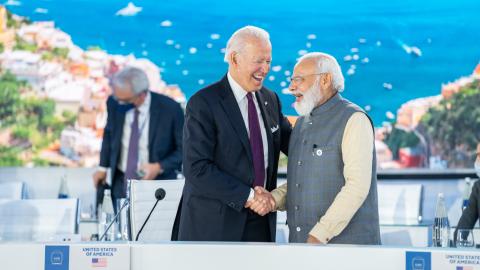The United States has just raised its bet on strategic partnership with India. High-level exchanges have increased and will culminate with Prime Minister Narendra Modi’s official visit to Washington in June and President Biden’s participation in the G-20 summit in Delhi in September. India and the US have also agreed to expand their economic and technological ties.
Still, India has made it clear that it is not, and does not wish to be, a US ally in a US-led world order. As president of the G-20, India is advancing the case for reinvigorating multilateral institutions and for advanced nations to cater to the demands of what India calls the “global south.” The Biden administration appears to concede that India’s diplomatic leverage and soft power could be useful for US goals in a world that no longer sees America as a sole superpower.
2023 is seen in Delhi as the year of India. The country is hosting summits of both the G-20, comprising the world’s largest economies, and the China-led Shanghai Cooperation Organization (SCO). India would have liked more agreement on global issues at the G-20 foreign ministers meeting earlier this month, but that did not happen because of differences over the war in Ukraine. The meeting in Delhi did provide an opportunity for US Secretary of State Antony Blinken to meet his Russian counterpart, Sergei Lavrov, for the first time since the start of the Ukraine war.
In the absence of a joint statement, the Indian government released a document summarizing the G-20 ministerial meeting, reflecting the views of 18 of the 20 members who condemned the Ukraine invasion while Russia and China did not. India, Indonesia, South Africa and Saudi Arabia, which normally abstain at the United Nations on resolutions tied to Ukraine, appeared willing to moderate their tenor at this meeting, likely influenced by India.
India continues to walk a tightrope in maintaining close ties with the US while retaining its strategic autonomy. Blinken’s trip came a few days after Treasury Secretary Janet Yellen’s visit to India for a meeting of G-20 finance ministers. During that visit, Yellen reiterated that the US is keen to continue “friendshoring” – shifting the manufacturing of certain critical components to friendly countries – with India.
The US Treasury secretary also announced that the US would provide funding for Indian technology startups and infrastructure projects from its $200 billion Partnership for Global Infrastructure and Investment (PGII) Fund. To affirm the centrality of economic exchanges in the India-US relationship, President Biden applauded the purchase of 220 Boeing aircraft by India’s recently privatized flag carrier, Air India.
Earlier, in January, the national security advisors of India and the US announced the launch of the US-India Initiative on Critical and Emerging Technologies (iCET). This strategic technology partnership is obviously related to US concerns about China, which India seems to share. But India is unlikely to concede the US desire that India integrate its technologies with those of the US and shun Chinese and Russian technology altogether.
India wants to build indigenous telecommunications systems. The US appears prepared for greater sharing of technology and collaboration for India’s long-standing desire for indigenization—the “make in India” projects. The Biden administration’s announcement about providing funding for the Indian tech sector is meant to show how various initiatives could complement each other.
The next generation telecommunications sub-initiative paves the way for research and development cooperation in 5G and 6G technologies and the deployment and adoption of open radio access network (RAN). A Defense Innovation and Technology Cooperation sub-initiative seeks to build a new bilateral Defense Industrial Cooperation Roadmap that will “accelerate technological cooperation” in military technologies.
In addition to the existing proposal by General Electric Aerospace to jointly produce jet planes in India, there is also talk now of co-development of drones, next generation aircraft and naval vessels. Under iCET, both sides will work together in the fields of artificial intelligence, quantum technologies, advanced wireless technology, space and semiconductor supply chain resilience.
The Biden administration describes the partnership with India as not being simply about China or Russia but as America’s most important relationship in the 21st century. Helping India strengthen its economic fundamentals and build a technological infrastructure with strong links with the United States is deemed to be beneficial to the US in and of itself. Even India’s drive for indigenization is seen as building another American partner that could counter the influence of Russia and China as a supplier of technology and defense equipment to other countries.





















